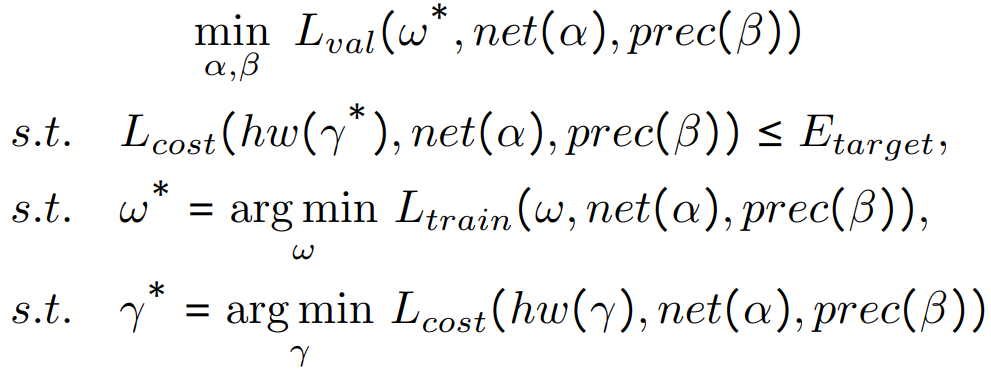Auto-NBA: Efficient and Effective Search Over the Joint Space of Networks, Bitwidths, and Accelerators
Yonggan Fu, Yongan Zhang, Yang Zhang, David Cox, Yingyan Lin
Accepted at ICML 2021 [Paper Link].
- While maximizing deep neural networks’ (DNNs’) acceleration efficiency requires a joint search/design of three different yet highly coupled aspects, including the networks, bitwidths, and accelerators, the challenges associated with such a joint search have not yet been fully understood and addressed. To tackle these daunting challenges towards optimal and fast development of DNN accelerators, we propose a framework dubbed Auto-NBA to enable jointly searching for the Networks, Bitwidths, and Accelerators, by efficiently localizing the optimal design within the huge joint design space for each target dataset and acceleration specification.
- Our Auto-NBA targets a scalable yet generic joint search framework, which we formulate as a bi-level optimization problem:
- To tackle the dilemma between memory explosion or biased search of bit-wise search, we propose a simple yet effective heterogeneous sampling strategy:
- We propose a differentiable search engine to efficiently search for the optimal accelerator (including the micro-architectures and mapping methods) given a DNN and its precision:
- We propose the single-path forward / multi-path backward strategy during joint search and acquire the layer/block-wise hardware cost using the single-path network derived from the current forward as a proxy of the finally derived network, which tackles (1) the prohibitively large joint space, (2) the entangled co-adaptation and cooperation issues among different network and precision choices, and (3) the chicken-and-egg problem associated with network-accelerator co-search.
- The searched networks by our Auto-NBA consistently push forward the frontier of accuracy-FPS trade-offs, compared to all SOTA baselines. For example, compared with the most relevant baseline EDD, we achieve a +1.3% higher accuracy together with a 1.59× better FPS.
- A two-stage process is needed to generate the matched network/bitwidth/accelerator solutions, i.e., the search and training stage. The corresponding settings are specified in config_search.py and config_train.py, respectively. In particular, plz specify the search settings in config_search.py and search the optimal network/bitwidth/accelerator solutions through train_search.py. Next, specify training settings in config_train.py and train the searched network/bitwidth from scratch through train.py (The best searched arch will be saved at ckpt/search/arch.pt which is the default path for train.py to read.)
- See env.yml for the complete conda environment. Create a new conda environment:
conda env create -f env.yml
conda activate pytorch
- Specify the search setting in config_search.py:
C.dataset_path = "path-to-dataset"
C.latency_weight = 1e-10
- Run train_search.py:
python train_search.py
- Specify the training setting in config_train.py:
C.dataset_path = "path-to-dataset"
C.load_path = "path-to-searched-arch"
- Run train.py on each of your nodes:
python train.py
@article{fu2021auto,
title={Auto-NBA: Efficient and Effective Search Over the Joint Space of Networks, Bitwidths, and Accelerators},
author={Fu, Yonggan and Zhang, Yongan and Zhang, Yang and Cox, David and Lin, Yingyan},
journal={arXiv preprint arXiv:2106.06575},
year={2021}
}





